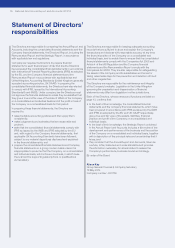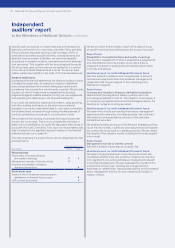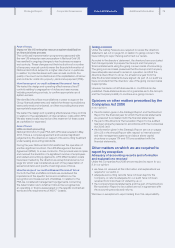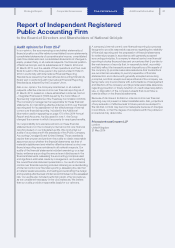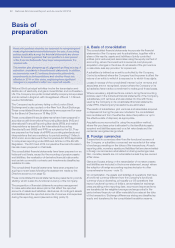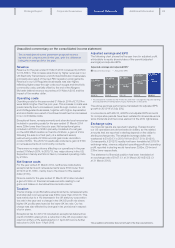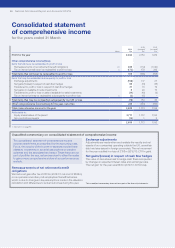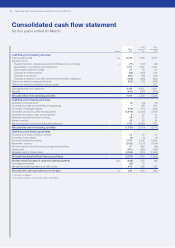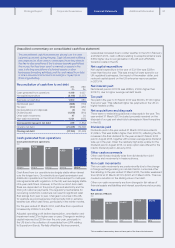National Grid 2014 Annual Report Download - page 84
Download and view the complete annual report
Please find page 84 of the 2014 National Grid annual report below. You can navigate through the pages in the report by either clicking on the pages listed below, or by using the keyword search tool below to find specific information within the annual report.
Accounting policies describe our approach to recognising and
measuring transactions and balances in the year. Accounting
policies applicable across the financial statements are shown
below. Accounting policies that are specific to a component
ofthe financial statements have been incorporated into the
relevant note.
This section also shows areas of judgement and key sources of
estimation uncertainty in these financial statements. In addition,
we summarise new EU endorsed accounting standards,
amendments and interpretations and whether these are
effective in 2014 or later years, explaining how significant
changes are expected to affect our reported results.
National Grid’s principal activities involve the transmission and
distribution of electricity and gas in Great Britain and northeastern
US. The Company is a public limited liability company incorporated
and domiciled in England, with its registered office at 1-3 Strand,
London WC2N 5EH.
The Company has its primary listing on the London Stock
Exchange and is also quoted on the New York Stock Exchange.
These consolidated financial statements were approved for issue
by the Board of Directors on 18 May 2014.
These consolidated financial statements have been prepared in
accordance with International Accounting Standards (IAS) and
International Financial Reporting Standards (IFRS) and related
interpretations as issued by the International Accounting
Standards Board (IASB) and IFRS as adopted by the EU. They
areprepared on the basis of all IFRS accounting standards and
interpretations that are mandatory for periods ending 31March
2014 and in accordance with the Companies Act 2006 applicable
to companies reporting under IFRS and Article 4 of the EU IAS
Regulation. The 2013 and 2012 comparative financial information
has also been prepared on this basis.
The consolidated financial statements have been prepared on an
historical cost basis, except for the recording of pension assets
and liabilities, the revaluation of derivative financial instruments
andcertain commodity contracts and investments classified as
available-for-sale.
The consolidated financial statements have been prepared on
agoing concern basis following the assessment made by the
Directors as set out on page 52.
These consolidated financial statements are presented in pounds
sterling, which is also the functional currency of the Company.
The preparation of financial statements requires management
tomake estimates and assumptions that affect the reported
amounts of assets and liabilities, disclosures of contingent assets
and liabilities and the reported amounts of revenue and expenses
during the reporting period (see accounting policy C).
A. Basis of consolidation
The consolidated financial statements incorporate the financial
statements of the Company and its subsidiaries, together with a
share of the results, assets and liabilities of jointly controlled
entities (joint ventures) and associates using the equity method of
accounting, where the investment is carried at cost plus post-
acquisition changes in the share of net assets of the joint venture
or associate, less any provision for impairment.
A subsidiary is defined as an entity controlled by the Company.
Control is achieved where the Company has the power to affect the
returns of an entity to which it is exposed or to which it has rights.
Losses in excess of the consolidated interest in joint ventures and
associates are not recognised, except where the Company or its
subsidiaries have made a commitment to make good those losses.
Where necessary, adjustments are made to bring the accounting
policies used in the individual financial statements of the Company,
subsidiaries, joint ventures and associates into line with those
used by the Company in its consolidated financial statements
under IFRS. Intercompany transactions are eliminated.
The results of subsidiaries, joint ventures and associates acquired
or disposed of during the year are included in the consolidated
income statement from the effective date of acquisition or up to
the effective date of disposal, as appropriate.
Acquisitions are accounted for using the acquisition method,
where the purchase price is allocated to the identifiable assets
acquired and liabilities assumed on a fair value basis and the
remainder recognised as goodwill.
B. Foreign currencies
Transactions in currencies other than the functional currency of
theCompany or subsidiary concerned are recorded at the rates
ofexchange prevailing on the dates of the transactions. At each
reporting date, monetary assets and liabilities that are denominated
in foreign currencies are retranslated at closing exchange rates.
Non-monetary assets are not retranslated unless they are carried
at fair value.
Gains and losses arising on the retranslation of monetary assets
and liabilities are included in the income statement, except where
the adoption of hedge accounting requires inclusion in other
comprehensive income – note 15.
On consolidation, the assets and liabilities of operations that have
a functional currency different from the Company’s functional
currency of pounds sterling, principally our US operations that
have a functional currency of dollars, are translated at exchange
rates prevailing at the reporting date. Income and expense items
are translated at the weighted average exchange rates for the
period where these do not differ materially from rates at the date
ofthe transaction. Exchange differences arising are classified as
equity and transferred to the consolidated translation reserve.
Basis of
preparation
82 National Grid Annual Report and Accounts 2013/14






